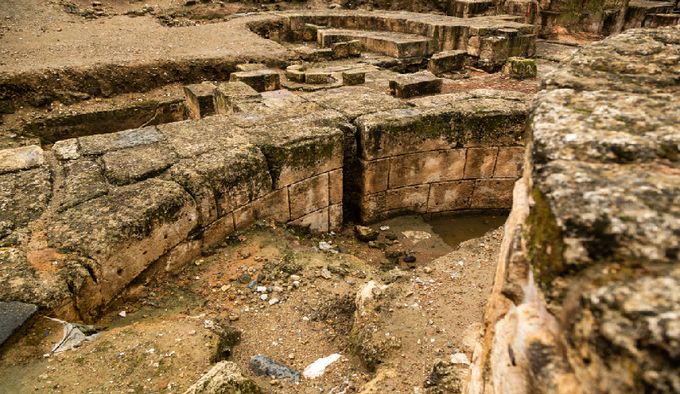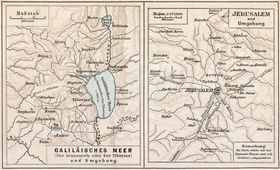7 Interesting Facts About Caesarea Philippi in Israel
Published April 28, 2025

Caesarea Philippi is an ancient city set at the base of Mount Hermon. In this article, we list 7 of the most interesting facts about this historic city.
Known by many names over the years, for a long time it was called Panias, after the Greek god of pastoralism, Pan. At that time, paganism was practiced in the form of numerous ceremonies in the caves located there. The city itself was situated in northern Israel in the southwestern foothills of Mount Hermon, roughly 20 miles north of the Sea of Galilee.
1. Caesarea Philippi Was Named in Honor of Caesar Augustus
Philip the tetrarch reigned from 4 BCE to 33 CE and wanted to honor Caesar Augustus, Roman emperor and great nephew of the renowned Julius Caesar, and so renamed the town “Caesarea”, with his name added to differentiate it from the harbor city of Caesarea Maritima.
Although this is how the city got its name, each subsequent ruler renamed it; today it is known as Banias.
2. The People of Caesarea Philipi Believed in Gates to the Underworld
Since the people of Caesarea Philipi were pagan, they worshipped shrines of different gods (like the Grotto of Pan) and believed they knew the location of the Gates of Hell.
The steep cliff overlooking the city was home to caves and a natural spring. The people of Caesarea Philippi believed that the gods of fertility - who allowed successful harvests and, therefore, survival - retreated to the underworld in winter.
The deepest crevices of the depths of the caves were believed to be the gates to the underworld, and the spring that came from there was believed to be the mode of transportation from hell to earth. However, as every year is different, the people felt the need to entice the gods out at the beginning of every spring season to make sure their harvests would be fruitful. They did this by committing sinful sexual acts (such as sexual relations with goats, as Pan was half-goat) at the shrines located at the entrances to the caves.
3. Jesus Revealed His Identity Here
Jesus brought his disciples to the city to reveal his identity as the Son of God, or the Messiah, making this one of the most significant places in the bible.
4. Jesus’ Church Began Here
Jesus asked his disciples, “Who do people say I am?”. After a variety of answers, Peter said: “You are the Messiah, the Son of the living God”.(Matthew 16:16) This was the beginning of Jesus' church.
At first, Caesarea Philippi may seem like a strange choice of location for Him to do this; however, we learn in the bible that Jesus chose this place for a special reason. He instructed the disciples to build a church that would heal even the most extreme manners of evil.
Jesus' actions here embodied the Paul’s words in 1 Corinthians 1:27–29:
The disciples had to essentially take on the gates of hell using the strength of their faith in Jesus Christ. They needed to show no shame, and show their faith confidently to the lost people of Caesarea Philippi. "If anyone is ashamed of me and my words, the Son of Man will be ashamed of him when he comes in his glory".(Luke 9:26)
5. Caesarea Philipi Was the Location of Saint Veronica’s Story
The original Saint Veronica was not only the woman who wipes the face of Christ as he carries the cross, but Veronica from Caesarea Philippi, who had an issue of the blood that was healed here by Jesus.
6. The Modern Location Is an Important Christian Pilgrimage Site
The timeline of Caesarea Philippi is intriguing. After many years of Roman and Agrippan rule (alternating between the powers), the city became an important Christian pilgrimage site. After a time of relative obscurity, it was taken by Muslims, and then Crusaders (1129-1163 CE). Another period of obscurity followed, until excavations beginning in the early 19th century revealed numerous incredible ancient sites.
Today, the city and its archaeological remains are carefully preserved. Must-see sites include the ruins of Agrippa's palace, the cardo, a bath-house and a Byzantine-period synagogue. It also contains a Byzantine church set on top of the remains of a Roman-era Pan temple built around 400 CE, thought to commemorate Jesus's interactions with Peter.
7. Caesarea Philippi Is Now Surrounded by the Hermon Nature Reserve
The Hermon Nature Reserve is the home of the very same gorgeous natural spring experienced by the ancient pagans, the mesmerising Banias waterfall (split into two streams by a tree), and numerous bird and butterfly species (many of which only came into existence in the 1960s).
Caesarea Philippi's Meaning
The ancient city is a must-see for Christians, history enthusiasts and nature lovers. Some might argue this is one of the most biblically important religious sites in Israel, owing to Jesus's declaration, revealing his true identity.







